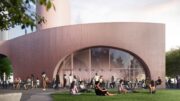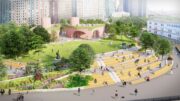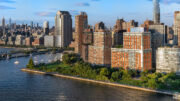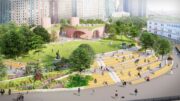The Waterfront Alliance has announced that the South Battery Park City Resiliency Project has become the 13th project nationally to achieve Waterfront Edge Design Guidelines (WEDG) verification. This distinction places the project, which is located at 20 Battery Place in Lower Manhattan, at the forefront of resilient, ecological, and accessible waterfront design.
The South Battery Park City Resiliency Project is designed to protect a significant segment of Lower Manhattan, including landmarks like the Museum of Jewish Heritage, Wagner Park, and Pier A Plaza. This area has been planned to counteract events related to sea level rise, such as coastal flooding and storm surges.
Developed in collaboration between the Battery Park City Authority and AECOM’s design team, the project introduces a range of resilience features integrated into the site. Wagner Park will undergo a transformation that that will conceal its seawall and resilience infrastructure. The park’s elevation will increase by 10 feet as a result of the project, offering protection against storms and providing expansive views of the New York Harbor. Additionally, the existing stone riprap along Pier A Inlet will be replaced with new terraced plantings to attract marine life, coupled with an overlook for educational purposes.
Throughout the design process, emphasis was placed on stakeholder engagement, leading to design alterations such as lawn scaling, safety enhancements, and a realigned bikeway. The project also prioritizes universal access, ensuring that all park users can navigate the site.
“In Battery Park City, with the urgency and care the moment demands, we’re adapting our waterfront to address climate change and simultaneously creating an even more beautiful and accessible park space for our residents and visitors,” said Battery Park City Authority president and CEO, Raju Mann. “We are honored to attain WEDG Verification from the Waterfront Alliance, an organization that has helped shape the New York City’s waterfront. The South Battery Park City Resiliency Project, including the redesigned and revitalized Wagner Park, will set the new standard for waterfront design excellence, flood protection, and functionality for the next generation of New Yorkers.”
Subscribe to YIMBY’s daily e-mail
Follow YIMBYgram for real-time photo updates
Like YIMBY on Facebook
Follow YIMBY’s Twitter for the latest in YIMBYnews






It will be interesting to see if some of the trees survive being so close to salt water. Many years ago, there was a much-heralded idea to plant trees along the western side of Flushing Creek, a tidal marsh All of these died in short order. One would need mangrove trees in this situation.
And yet the plan destroyed every inch of green space and all that heavy equipment and concrete have a huge carbon footprint. Less expensive and lower impact plans were rejected outright, but these awards never consider such factors. Sort of like JP Morgan getting a LEED award for destroying a newly renovated building.
Shhhh. Let the developers have their feel-good “everyone gets a trophy” moment.
The only recognition that holds some value is the Living Building certification. I would be immensely impressed if any NYC project were able to achieve such, regarding the scale of similar stuff.
A Highline-like or raised green-space promenade would elevate the human spirit while opening opportunities for further layers of protective engineering in the future.